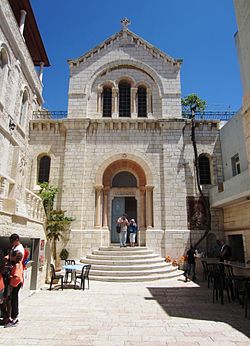Church of Our Lady of the Spasm, Jerusalem
| Church of Our Lady of Sorrows | |
|---|---|
| Hebrew: כנסיית גבירתנו הדואבת | |
 Entrance of the Church of Our Lady of Sorrows | |
| Location | Old City of Jerusalem |
| Country | Israel/Palestine |
| Denomination | Armenian Catholic Church |
| History | |
| Dedication | Our Lady of Sorrows |
| Architecture | |
| Heritage designation | World Heritage Site of UNESCO (1981) |
| Completed | 1881 |
| Administration | |
| Diocese | Armenian Catholic Patriarchal Exarchate of Jerusalem and Amman |
| Clergy | |
| Exarch(s) | Krikor Bedros XX Gabroyan |
The Church of Our Lady of Sorrows (Hebrew: כנסיית גבירתנו הדואבת),[1] or the Church of Sorrows of Mary, also called the Armenian Chapel of Our Lady of the Spasm, is an Armenian Catholic church building in the Old City of Jerusalem[2] erected in 1881.[3]
Located at the fourth station on the Via Dolorosa, not far from the Ecce Homo Arch and across the street from the Austrian Hospice in the Muslim Quarter of the Old City of Jerusalem, it commemorates Jesus' encounter on the way to his crucifixion with his mother.[4] The building includes a chapel dedicated to the Virgin Mary, and is thus named in dedicated to her under the title Our Lady of Sorrows.
As the seat of the Armenian Catholic Patriarchal Exarchate of Jerusalem and Amman of the Armenian Catholic Church, an Eastern Catholic particular church sui iuris in full communion with the Pope in Rome, and the Catholic Church,[5] the church building holds the status of cathedral. The facility is also the Armenian Catholic hospice in Jerusalem.
It is a World Heritage Site of UNESCO since 1981.[2]
See also
References
- ^ ""Church of Our Lady of Suffering – Armenian catholic – Jerusalem Articles"". Archived from the original on 2017-06-15. Retrieved 2016-05-17.
- ^ a b "Church of Our Lady of the Spasm, Jerusalem, Israel (Armenian)". www.gcatholic.org. Retrieved 2016-05-18.
- ^ Israel, a Phaidon Art and Architecture Guide. Prentice Hall Press. 1987-01-01. ISBN 9780135063200.
- ^ "Via Dolorosa, the extended version". Hotel Eden Tiberias. 2016-04-11. Archived from the original on 2016-05-17. Retrieved 2016-05-17.
- ^ "Our Lady of Sorrows « See The Holy Land". www.seetheholyland.net. Archived from the original on 2016-06-11. Retrieved 2016-05-17.

